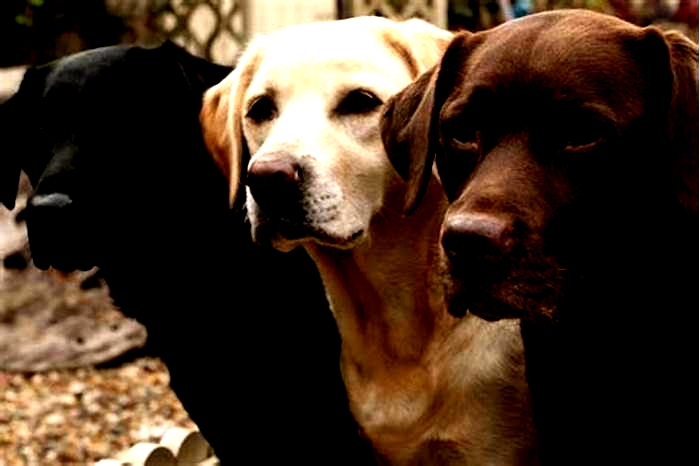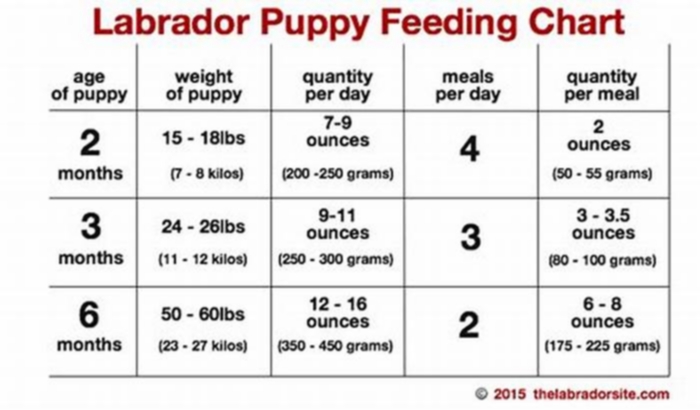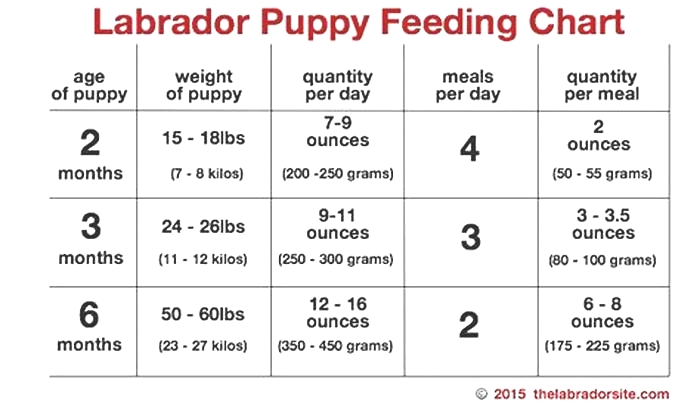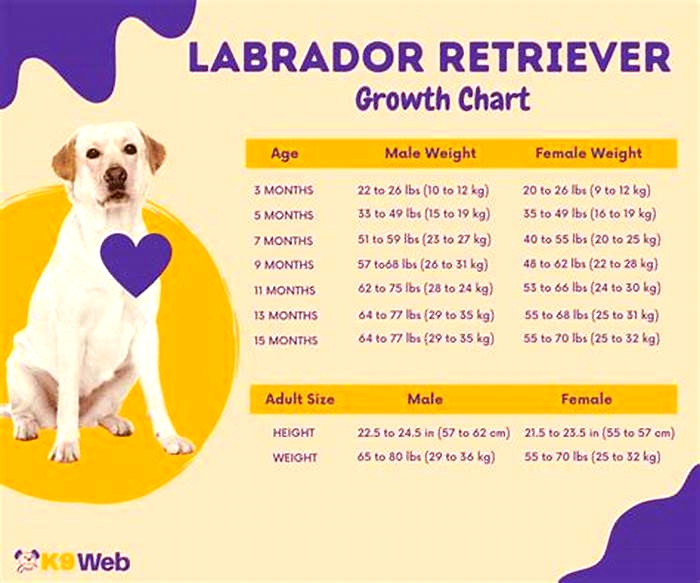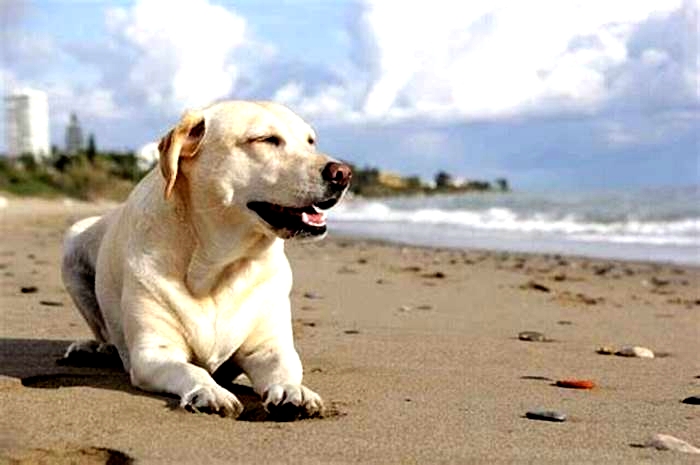Why is my Labrador so fat
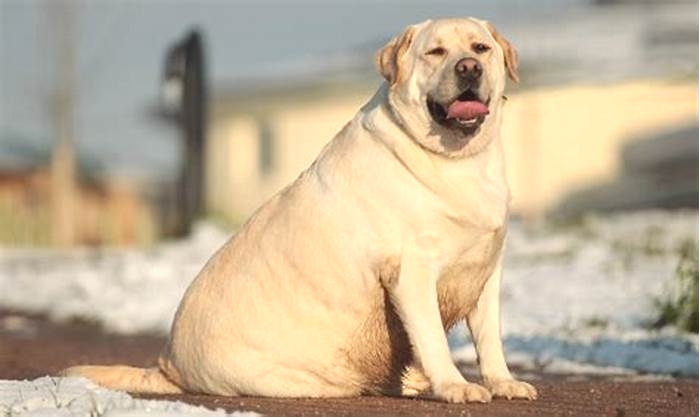
Why Is Your Labrador So Big? Size and Height Facts
What Is the Normal Size and Height for a Labrador?
According to theAmerican Kennel Club, male Labradors average 22.5- 24.5" (57.2-62.2 cm) tall, while females are typically 21.5-23.5" (54.6-59.7 cm) tall. Male Labs weigh between 65-80 lbs (29.5-36.3 kg) on average, while females typically weigh 55-70 lbs (25-31.8 kg).
| Males | Females | |
|---|---|---|
| Average height range | 22.5-24.5 (57.2-62.2 cm) | 21.5-23.5 (54.6-59.7 cm) |
| Average weight range | 65-80 lbs (29.5-36.3 kg) | 55-70 lbs (25-31.8 kg) |
Labs vary in size based on several factors. Males and females have different height and weight ranges, and specific breed lines may be taller and thinner than their counterparts.
TheAKC official standardfor a Labrador Retriever states the following specifications for its general appearance:
- Strongly built
- Medium-sized
- Short-coupled
- Athletic
- Well-balanced
- Powerful jaw
- Proportionate substance and bone
- Shall not appear light or "weedy"
- Well-muscled
- No excess fat
- Short, broad, and strong loins
- Well-developed hindquarters
- Muscular forequarters
However, it's important to note that the standards for the breed are based on a grown adult Labrador. The size standards for puppies are more flexible as they go through rapid growth and development periods.
According toPet Finder, you can estimate your Lab's adult weight by multiplying the puppy's weight at 14 weeks by 2.5. I'm personally not a big fan of this approach, but it can be a fun exercise to try to guess.
As a general rule, Lab puppies should follow pretty closely with the growth chart I provided in How Big Do Labs Get? Should You Be Worried?
Is Your Labrador Overweight or Obese?
Labs are prone to unhealthy weight gain, but many owners don't realize where the line between "cute fat" and "unhealthy fat" lies. As a dog lover, I too am guilty of sometimes overindulging or otherwise enabling my own pooch's love of kibble.
Make sure that your Lab is eating the right amount per day. We discuss this in detail in the article: How Often Should You Feed a Labrador? Why Feeding Routines Matter.
Another way to determine if your Lab is overweight or obese is by comparing its weight to the "ideal weight" similar to howBMIis used as a benchmark to determine obesity in humans.
If your Lab's weight is more than 15% over its ideal weight range it is considered overweight. A variation of 30% over the ideal weight range is considered to be obese.
Why Is Your Lab Bigger Than Normal?
According to research published inCell Metabolism,some Labradors are predisposed to weight gain due to agenetic mutation. More than one-fifth of Labs have this genetic variation. As a result, Labradors are more prone to overeating because their brains may not "turn off" their hunger after eating.
Though the average size and height measurements are considered standard for the breed, there are always variations between animals. Weight gain is a common problem among Labs, and many owners have to address it as their pup ages.
Obesity is a big problem among most dogs, with one in three dogs in the U.S. weighing in the obese range.
Aside from physiological factors for your Labrador's size, another explanation is that the larger size results from breeding. Lineage can be responsible for variations in the size and height of your four-legged friend.
Other Reasons for Weight Gain
There areother contributorsto changes in your Labrador's size, particularly when it comes to weight gain and the prevalence of obesity. Some of the most common causes for your Lab to get bigger include:
- Age:As animals get older, their lean muscle begins to decline, causing their body's caloric need to drop. In addition, many dogs experience a decrease in overall activity level with age. When dogs continue to eat the same amount of food despite reducing calorie and energy usage, the dog will gain weight.
- Spaying and neutering: The reduction of sex hormones in the dog's body generally slows down his metabolism, which increases weight gain. These hormonal changes can also affect how your pup regulates his hunger and satiety.
- Medications:Some medications can prompt dogs to eat more by stimulating appetite or affect how fat is deposited throughout the body.
- Diet and nutrition: Feeding your Lab too much, giving it too many snacks, or feeding it table food can all increase the risk of obesity. Similarly, the quality of the food and nutritional value can also impact the dog's weight.
- Owners' activity: The dog owner's activity level may also have an effect on whether a dog is overweight. Someresearchhas shown that obese dogs are more likely to have obese owners.
What Should You Do About Your Big Labrador?
The first step to control your Lab's weight is to ensure you are feeding it the appropriate amount. You may have heard the myth that a Lab will eat itself to death if you allow it. While this is very unlikely, your Lab may still overeat if you allow free feeding.
One way to help slow down your Lab while he's eating is by using a puzzle bowl.
ThisKasbah slow feeder (Amazon)dog bowl helps prevent rapid eating through its specially designed shape. I like these bowls because they help prevent choking, bloating, and digestive problems.
Labradors are also a very active breed. According to theAKC, Labs require a significant amount of exercise to keep their bodies and minds healthy. You can help your Lab maintain its fit figure by spending time outdoors and taking it to do things like running and swimming.
If, despite your efforts, your pup remains on the larger side, consider consulting a veterinarian. They will be the best resource to address any concerns you may have about your dog's weight or size.
Conclusion
If your Labrador seems too big for his breed, he may be overweight or obese. Common reasons for obesity include:
- Labradors have a genetic predisposition to overeating and weight gain.
- Over time, dogs naturally begin to engage in less physical activity, and their metabolism slows down.
- The feeding habits of the owner and the dog's physical characteristics often contribute to weight gain.
By paying attention to your Lab and recognizing when a size variation is a potential health problem, you can quickly respond and get your pup back on track to a healthy body and lifestyle.
Is My Labrador Too Thin?
When a Lab looks much leaner than their pals at the dog park, their owner might worry is my Labrador too thin? Labradors overall body condition is a better indicator of whether theyre in healthy shape than their weight. If they have visible ribs or vertebrae, its possible they are too thin. A veterinarian is best placed to make this judgement, and identify the reason why.
Is My Labrador Too Thin?
Overall, Labradors are better known for overeating and being prone to obesity, than being too thin. But not all Labs are insatiable, and not all weight loss in dogs is solely the result of undereating.
In this article, we look at the lower threshold of the healthy weight range for Labs, and how to tell if your dog is getting close to it, or below it. If you like, you can use these links to navigate straight to specific topics:
Lets start by looking at the normal Labrador physique, so that its possible to recognize when a Lab is underweight in comparison.
Are Labs Naturally Skinny?
The shape of a Labrador Retriever is iconic and easily called to mind for most of us. That they all mostly fit the same template is due to a clear description of the ideal Labrador conformation set out in their breed standard. The standard is littered with adjectives like strong, developed and powerful. It also requires Labs to have a moderately wide chest, and be short coupled (which means the distance from their ribs to their pelvis is relatively short, compared to dogs on average).
These features have the combined effect of making the Labrador look more naturally heavy and bulky, than thin and gangly.
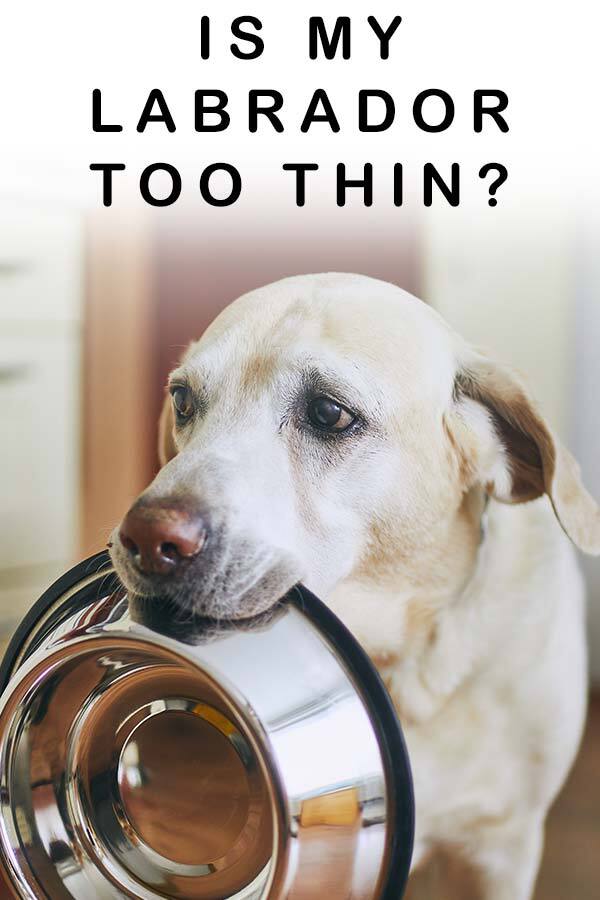
But undoubtedly, if youre lucky enough to meet a lot of Labs, youre likely to meet some which look very slender, and others which look very chunky. This is partly due to natural variation in size, and lifestyle factors. But theres another important reason why a lot of Labs in the U.S. look slim and racy, whilst a smaller proportion look broader and more heavy set.
Different Labrador Shapes: American vs English
Breeding choices and different opinions about how the ideal Labrador looks on either side of the Atlantic has led to two distinct types of Lab English and American. They both belong to the same breed, but English Labs tend to be broader, stockier, and more heavy set. Whilst American Labs tend to be taller, longer, and slimmer looking.
In the U.S. most Labs, predictably, belong to the American type. A smaller proportion belong to the English type. So the general perception of Labrador body shape in the U.S. is slimmer than Lab owners in the UK are used to. But whats the ideal weight range for either type?
What Is The Ideal Weight For A Labrador?
The American Kennel Club describes the ideal weight of Labs in working condition as
- approximately 65 to 80 lbs for males
- and approximately 55 to 70 lbs for females.
The Kennel Club in the UK doesnt specify an ideal weight for English type Labs. But around 70 to 80 lbs for a male and 60 to 70 lbs for a female is typical. For both types, you can see that theres a significant difference in size between the largest and smallest individuals in each sex class. And its possible to have healthy individuals which fall outside of the average range too. Which is why relying on numbers on a scale isnt the best way to determine if your Labrador is at their ideal weight.
How Else Can I Tell If My Labrador Is Too Thin?
This is where overall body condition comes in. Vets assess body condition partly by observing a dogs outline from the side, and from above. Labradors at a healthy weight have a discernible waist from above, and from the side their belly is tucked up slightly higher than their chest.
Vets also examine body condition by touch applying pressure over the ribs to assess how much fat is covering them, for example. Dogs in healthy condition have ribs which can be easily felt under a thin layer of fat.
How Can I Tell If My Lab Is Underweight?
Overall body condition is a better way of identifying whether your dog is at a healthy weight than putting them on the scales alone, because it works regardless of what sex your Lab is, how tall they are, and whether they are big or small in stature generally. Unfortunately, us dog owners arent instinctively very accurate at assessing our dogs body condition. Even using a body condition score chart, we tend to underestimate their size.
Or in other words, were more likely to think theyre healthy when in fact theyre overweight. And we tend to think theyre underweight when theyre actually in optimum condition. In fact, only half of us ever get it right! However, if you can see any of these changes in your dog it is possible that they are underweight:
- Visible ribs, vertebrae or pelvic bones.
- Or being able to feel any of those bones immediately under the skin with no fat covering them at all.
- Loss of muscle mass.
- The underline of their body (the shape of their ribs and belly sideways on) following an S-like curve. In ideal condition, the underline of adult Labradors slopes up towards the hindquarters, but in a straight line.
If any of these apply to your Lab, we recommend asking a vet to check them over. Even without any of these features, always report any unexplained weight loss to your dogs vet too. There are several possible causes of emaciation (being underweight) in dogs, and its important for a vet to decide which one applies, and how to manage the weight loss.
Causes Of Weight Loss In Dogs
There are several reasons a Labrador can get too thin. One is not eating enough calories to replace all the energy they burn in a day. Other reasons include
- parasitic infection such as leashmaniasis and parvovirus
- cancer
- liver disease
- kidney disease
- and hereditary muscle wasting conditions such as muscular dystrophy, and myopathy.
And as you can easily imagine, none of these are treated as simply as by giving the dog more calories in their diet! Its also worth bearing in mind that Labradors dont reach their adult weight until theyre about a year old, and its not uncommon for them to go through a skinny teenage phase whilst theyre still growing.
However, being too skinny during their growing months can also have a damaging effect on things like bone development. So its really important that a vet determines whether your Lab is too thin, and whether they need help gaining weight.
How Can I Fatten Up My Labrador?
Once any underlying causes of being too thin have been resolved, your vet may recommend adjusting a dogs diet to help them gain weight. Sometimes the simplest way of doing this is by overfeeding their usual diet a little every day, until they reach a healthy body condition. But your vet might also recommend switching to a more energy rich diet.
Whats important is to be led by your vet. Making sudden changes to a dogs diet without veterinary expertise can cause digestive upset and diarrhea which may make weight loss worse!
Is My Labrador Too Thin Summary
The chances are that youre here because youre concerned that your Lab might be underweight, and you want to make an informed assessment of their condition. Its great that youre doing that!
All Labs should have an owner that pays attention to their welfare so closely, and cares about them so much. But if youre worried about your dog, only allow a veterinarian to put your mind at ease. The truth is that a lot of dogs we perceive as being underweight are actually in a healthy condition. A vet will be able to determine whether they are really too skinny, and if so why, and how to safely fatten them up.
Readers Also Liked
References & Further Reading
Bergman et al. Dystrophin-Deficient Muscular Dystrophy in a Labrador Retriever. Journal of the American Animal Hospital Association. 2002.
Dos Santos. Associations among immunological, parasitological and clinical parameters in canine visceral leishmaniasis. Veterinary Immunology and Immunopathology. 2008.
Hawthorne et al. Body-Weight Changes during Growth in Puppies of Different Breeds. The Journal of Nutrition. 2004.
Jeena. Diagnosis and clinico-therapeutic studies on canine hepatic dysfunction. G.B. Pant University of Agriculture and Technology. 2017.
Nwoha. Parvoviral enteritis in a dog: Case report and review of the literature. Continental Journal of Veterinary Science. 2011.
 (paid link)
(paid link)Raffan et al. A Deletion in the Canine POMC Gene Is Associated with Weight and Appetite in Obesity-Prone Labrador Retriever Dogs. Cell Metabolism. 2016.
Snead et al. Clinical Phenotype of XLinked Myotubular Myopathy in Labrador Retriever Puppies. Journal of Veterinary Internal Medicine. 2015.
Yam et al. Inaccurate Assessment of Canine Body Condition Score, Bodyweight, and Pet Food Labels: A Potential Cause of Inaccurate Feeding. Veterinary Sciences. 2017.
The Labrador Site Founder

Pippa Mattinson is the best selling author of The Happy Puppy Handbook, the Labrador Handbook, Choosing The Perfect Puppy, and Total Recall.
She is also the founder of the Gundog Trust and the Dogsnet Online Training Program
Pippa's online training courses were launched in 2019 and you can find the latest course dates on the Dogsnet website

